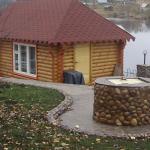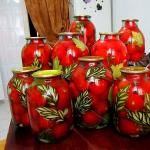Peculiarities of Slovak cuisine. Slovak cuisine: Pohutka needs to be washed down with Urpin Slovak cuisine recipes with photos
Many people traveling around Europe unfairly ignore Slovakia. There are practically no excursions there; people fly into Bratislava for a few hours on the way to Vienna on an excursion or back. One of my friends tried to buy a tour to Slovakia from Russia, the travel agency simply didn’t understand her and asked again: “maybe we should go to the Czech Republic after all?” I believe that every country has aspects that deserve attention. Slovaks are a very soulful people with rich traditions and a language so similar to ours, Russian. By the way, they love Russians, and our culture is close to them.
Maybe that’s why you can find such favorite dishes as cabbage soup and dumplings on the Slovak menu? As you may have guessed, today I will tell you about Slovak cuisine.
Slovak cuisine has been greatly influenced by neighboring countries - the Czech Republic, Poland, Ukraine and Hungary. Characteristic for the kitchen meat dishes (usually pork), potatoes, dumplings, thick sauces and cheeses. Sour sauerkraut is also common here. Bread is very important when eating in Slovakia.
So, let's look at what it consists of Slovak lunch.
The most famous first course is thick sauerkraut soup (kapustnica), which includes meat, sausages and mushrooms. The cabbage recipe varies depending on the region of the country. During fasting, cabbage soup is prepared without meat, but dumplings, sour cream and potatoes are added to it. Sometimes cabbage soup is compared to Russian cabbage soup.
If you don’t like cabbage, you can order garlic soup, which is usually served not in a plate, but in a loaf of bread.

Lovers of meat soups will appreciate it goulash soup, which is also served in a loaf of bread.

You can order for the second one cheese dumplings (bryndzové halušky), which include potatoes, flour and smoked pork with lard. Unlike Ukrainian dumplings, Slovak dumplings are saltier and smaller. As a rule, dumplings are served with a glass žinčica – a drink made from goat milk.
You can also choose one of the meat dishes for the main course. The variety of second courses is evidenced by menus from different restaurants.


We chose the goose leg with potato dumplings.

By the way, dumplings (knedľa)- a traditional Czech side dish - also popular here. Simply put, these are boiled pieces of dough or potatoes. They can have different fillings. There are even sweet dumplings. The photo below shows goulash with dough dumplings.

While eating, don't forget about beer. The most popular brands of beer in Slovakia are: Dobre pifko, Popper, Palatín, Šariš, Steiger, Topvar, Kelt.

You can order wine for dessert. The wine is produced in 6 wine-growing regions located in the southern part of Slovakia. Slovak wines are popular in neighboring countries. The most common grape varieties grown in Slovakia include Veltlínské zelené, Rizling vlašský, Frankovka modrá, Svätovavrinecké, Rulandské biele.

Our lunch is over, and finally I want to give you the addresses of two restaurants and cafes that we especially liked during our stay in Bratislava.
Restaurant Slovak pub
- Address: Bratislava, Obchodná 613/62
Restaurant Bratislavský Meštiansky Pivovar
- Address: Bratislava, Drevená 8 and Bratislava, Dunajská 21
Cafe Kaffee Mayer with amazing desserts
- Address: Bratislava, Hlavné námestie 4
I attach photos of the desserts below.
Slovak cuisine varies slightly in different regions of the country. In many ways, she absorbed the culinary traditions of her neighbors. The origins of traditional Slovak cuisine can be traced back to a time when the majority of the population lived self-sufficiently in villages with very limited food imports and exports, and without modern means of food storage or processing. Modern Slovak cuisine is heavily influenced by various world cuisines and uses many different ingredients, spices and industrial products.
Characteristic Products
Food of plant origin
Slovak cuisine relied heavily on a number of staple foods that could withstand both hot summers and cold winters. These include wheat, potatoes, sauerkraut and onions, as well as several other local vegetables, fruits and wild mushrooms. The wheat was ground and used to make bread, dumplings and noodles. Potatoes were mainly boiled or processed into potato starch.
Meat and fish
Pork, beef and poultry are the main meats consumed in Slovakia, with pork being the most popular. Typical pork products include sausages, smoked bacon and lard. To a lesser extent, beef, poultry, lamb, goat meat and eggs were traditionally consumed. Chicken is the most common poultry, although duck, goose and turkey are also consumed. Game is available throughout the year, especially wild boar, rabbit and venison. Horse meat is not eaten at all for ethical reasons.
Typically, the meat is either breaded, fried in oil (schnitzel), or cooked and served in a sauce. Hungarian influences in Slovak cuisine can be seen in popular stews and goulash. Grilled meat is not popular in Slovakia.
Dairy
Milk is consumed both on its own and processed into dairy products: butter, cream, sour cream, buttermilk and various types of cheese.
Spices
Spices are not widely used; instead of vegetable oils, animal fats and oil are often used.
Traditional dishes
Bread
Soups
Cabbage (Kapustnica) - soup made from sauerkraut with sausages.
Rezancová - chicken noodle soup.
Fazuľová - bean soup.
Demikát - light cheese soup. Cheese cheese is mixed with chopped onions and spices, poured with warm dumpling broth or vegetable broth until the consistency of a soft puree. Served with herbs and croutons fried in lard.
Flyaki is a soup made from beef tripe and tripe.
Main courses
Galushki (Halušky) is a traditional dish in the cuisines of Central and Eastern Europe, which consists of small dough dumplings (flour + water), which are then boiled in water. Dumplings can be either an independent dish or an addition to some other dish. Depending on the region, grated potatoes and eggs are added to the dough. After cooking, the dumplings are mixed with various ingredients: cheese, meat, butter, cabbage, onion or combinations thereof.
Bryndzové halušky is a national Slovak dish, potato dumplings with Bryndzové sheep cheese and bacon. Traditionally, they are washed down with the local drink Žinčica. Turetsk annually hosts the Galushka Fest festival, where participants compete not only in cooking, but also in eating everyone’s favorite dumplings.
Strapačky is a Slovak dish similar to cheese dumplings, in which stewed sauerkraut is used instead of cheese.
Pies (pirohy) - this is what dumplings or dumplings are called in Slovak cuisine, and not at all what we Russians mean by this word. The pies are often semi-circular, with typical fillings: potatoes, sauerkraut, ground meat, cheese and fruit. Can be served with gravy: melted butter, sour cream or fried onions. Pies are especially associated with Slovak and Polish cuisines, where they are considered national dishes.
Bryndzové pirohy is a national Serbian dish, dumplings stuffed with cheese.
Široké rezance s tvarohom slaninou - tagliatelle with cottage cheese and fried bacon.
Granatiersky pochod / granadír / granadírmarš - a dish of tripe with potatoes.
Segedin goulash - stewed pork with sauerkraut and cream or sour cream, usually served with boiled dumplings (knedľa).
Rezeň - schnitzel, usually breaded.
Chicken paprikash is chicken stewed with sweet peppers, usually served with dumplings.
Hungarian goulash is a spicy beef stew served with pieces of a large steamed dumpling.
Salads and snacks
Zemiakové placky - potato pancakes fried in oil.
Lokše - thin pancakes made from potato dough.
Liptovsky cheese (Liptauer) is a cheese snack made from feta cheese mixed with butter and spices. One of the spices used is sweet paprika. This is what gives the dish its reddish color.
Dessert
Traditional Slovak sweets are usually baked at home throughout the year, but especially at Christmas.
Buchty/Buchteln are sweet buns made from yeast dough, filled with jam, poppy seeds or cottage cheese, baked in one large pan so that the buns stick together. Traditional bays are filled with plum jam and topped with vanilla sauce and powdered sugar. Served mainly as dessert, but can also be used as a main dish.
Steamed buchty (Parené buchty) - donuts with various fillings (jam, cottage cheese, poppy seeds), steamed or stewed. Serve topped with vanilla cream and sprinkled with poppy seeds and powdered sugar. Similar to Austrian Germanknödl or Chinese baozi buns.
Laskonky - butter cream with walnuts between two halves of meringue.
Zhemlevka (Žemľovka) is a bread pudding or tender pie with apple and curd filling.
Macacie oči is a round shortbread cookie with a center filled with jam. In appearance they resemble eyes with a pupil, hence the name.
Ryžový nákyp - rice pudding.
Orechovník - a sweet roll filled with walnuts.
Makovnik (Makovník) - poppy seed roll.
Bratislava bagels (Bratislavské rožteky) are bagels with sweet fillings.
Trotle - two layers of round cookies with chocolate cream between them, half dipped in dark chocolate.
Medovníky - gingerbread cookies.
Bear paws (Medvedie labky) are brown nut shortbread cookies shaped like a bear's paw.
Trdelník (or Skalický trdelník) is a traditional pastry made from yeast dough that is baked on a rotating spit over an open fire. The production of trdelnik has a long tradition in the Slovak town of Skalica, near the borders with the Czech Republic. The original recipe was brought to Skalica at the end of the 18th century by the Transylvanian cook József Gvadányi, a retired Hungarian general. This recipe was later improved by the people of Skalitz to its current version, known as Skalický trdelník. Every year since 2007, Trdlofest has been held in Skalica, during which the longest trdelnik is baked. The name trdelník itself comes from the word “trdlo”, which means a wooden roller on which the dough is rolled before baking.
Beverages
Žinčica is a Slovak folk drink made from sheep whey, similar to kefir, and a by-product of the production of feta cheese. Traditionally served in a ladle (črpák), a wooden cup with a beautifully carved handle.
Alcohol
Serving and etiquette
The main dish of the day used to be lunch, which was eaten around noon. However, changing work regimes and office work have changed this usual way of life. Today, many Slovaks have their main meal of the day in the evening. Lunch in Slovakia usually consists of soup and a main course.
In Slovakia, it is customary to bring a bottle of wine or other alcohol as a gift if you are invited to visit your home.
Slovak cuisine is born from a combination of milk, potatoes, cabbage and their various derivatives. And of course, we can’t forget about meat.
Below we have collected for you the five main symbols of Slovak national cuisine.
1. Lard with cracklings
One of the simplest “aperitifs” before meals is sandwiches with lard. A mixture of fat rendered from pork or goose fat and cracklings (as well as spices, garlic or onions) is an absolutely simple, but very tasty thing. It is usually served in small bowls for spreading on bread. Each chef has his own “secret recipe”, so it’s worth trying the appetizer in different establishments. What you shouldn’t do is deliberately refuse to try it under the pretext of “fat content” - believe me, it’s delicious.
Lard with cracklings
depositphotos(c)ajafoto
2. Garlic vole
Vole - stew - is one of the main dishes in Slovak cuisine. It can be anything - meat, vegetable, cereal, but one of the simplest and most elegant is the “Chesnakov vole”. Its main composition is broth, flour, cream, spices and, in fact, garlic. And then there may be variations - from mushrooms and potatoes to fennel.

Garlic vole
depositphotos(c)vankad
3. Dumplings
This dish can be found in Slovak establishments in several variations. The most famous are with feta cheese, the Slovak equivalent of sushi for the Japanese, pizza for the Italians or fish and chips for the British. They are made from potato dough mixed with sheep cheese and served with fried lard, washed down with buttermilk or curdled milk. Fans of dumplings with cheese annually come to the Turecka mountain fortress at the foot of Velka Fatra for the world championship in their preparation and eating. But for our taste, the most magical dumplings are strapachki (a mixture of dumplings, sauerkraut and fried cubes of smoked lard).

depositphotos(c)phb.cz
4. Roast duck with stewed cabbage
The menu of almost any Slovak establishment with national cuisine is complete without fried duck with cabbage. Cabbage for poultry can be pickled, fried, stewed - white or red. Another variation on the theme is stuffed duck with cabbage. The basis of the minced meat is rice, walnuts and spices are added to it. A frequent companion of poultry with cabbage are dumplings, regular or potato. By the way, Branislav Krizan, chef of the Matyšák Hotel in Bratislava, advises: in order for the duck to turn out golden, when frying it should be poured not with the juice from the frying meat, but with milk.

Roast duck with dumplings and stewed cabbage
depositphotos(c)ajafoto
5. Skalicky trdelnik
And for dessert - trdelnik, tubes of dough baked on a trdlo (wooden spit) over an open fire and sprinkled with sugar or cinnamon. Skalick trdelnik is a pastry with walnuts, which is made according to the traditional recipe of monastery cuisine. In October 2007, Skalice trdelnik became the first Slovak food product to receive an EU protection mark. By the way, every year in Skalitz it is held
The cuisine of Slovakia is a “cocktail” formed from European cuisine (in particular, Hungarian, German and Austrian) and components of national flavor.
National cuisine of Slovakia
The basis of Slovak cuisine is dumplings, dumplings, meat, vegetables and cheese. Meat eaters will be delighted to consume roast duck with sauerkraut; pork envelopes with asparagus, chopped ham and cheese; game meat pates; baked goose with dumplings. It is impossible to imagine local cuisine without first courses - in Slovakia people eat vegetable, cheese, meat, mushroom and even garlic soups.
Fans of confectionery and baked goods will not miss the Slovak pancakes with peach filling and “longos” (donuts fried in oil to which garlic is added).
Popular dishes of Slovak cuisine:
- “baked boar's knee” (a dish in the form of a fried pork leg);
- “expressed cheese” (cheese fried in breading);
- “Spišská pohutka” (meat goulash dish with potato pancakes and champignons);
- potato lokshas with goose wings;
- stuffed chicken with paprika.
Where to try Slovak cuisine?
Before ordering anything from local restaurants, tourists are advised to familiarize themselves with the menu and prices. It is worth noting that most restaurants are concentrated in large cities and main regions, therefore, when vacationing away from tourist routes, you should prepare for the fact that food establishments will be much less common (it is advisable to look for them in hotels, hostels and boarding houses). Delicious food can be enjoyed in beer bars: Slovak pivnice offer food at lower prices than other food establishments.
It is recommended to satisfy your hunger in Bratislava at the “Slovak Pub” (guests here will enjoy Slovak cuisine - on the menu they will find potato dumplings with cheese and sour milk desserts, and there is no doubt that they will definitely serve feta cheese with cold beer) or “Modra Hviezda” (here you should try stewed beef with vegetables and spices, as well as baked boar’s knee).
Cooking courses in Slovakia
While staying at one of the eco-hotels in the Slovak city of Kosice, those wishing to be not only treated to seasonal dishes, but also given master classes on their preparation (if you wish, you can take part in cooking after the chef).
You can pamper yourself with proper organic nutrition in one of the Slovak farms, and if you wish, gastronomic master classes will be held for you, which involve preparing Slovak dishes yourself and tasting them with boletus and slivovitz.
A trip to Slovakia should be timed to coincide with the Wine Collection holiday in honor of the harvest of grapes and new wine (September), or the Winter Culinary Festival (January-February), dedicated to Slovak cuisine.
The national cuisine of Slovakia was formed under the influence of Hungarian, German, Czech and Austrian cuisines but, despite this, it has its own special flavor. The dishes here are quite simple and satisfying. Brands of Slovak cuisine include meat, cheeses, dumplings, dumplings, wine and beer.
In Slovakia you can taste delicious first courses with amazing aroma. It is worth trying cheese, meat, vegetable, mushroom and garlic soups and various broths.
Cheese is also widely used for preparing various dishes in this country. Here you will try “expressed cheese” - fresh cheese fried in breading, dumplings with feta cheese or shepherd’s dumplings with cheese.
Meat dishes in Slovakia are very similar to Czech, Hungarian and German dishes. Here you can try “baked boar’s knee”, “Spišskaya pohutka” - excellent meat goulash with champignons and potato pancakes, “baked goose with dumplings”, “pork envelopes” with cheese and asparagus and various sausages.
Those with a sweet tooth should definitely try the sweet pastries, which are very reminiscent of Austrian ones. It is also worth enjoying pancakes with peaches, fried donuts, Bratislava nut or poppy seed cones, Skalick trdelnik and very tasty cakes: rum, spitz, veternik and Bratislava.
I recommend trying national cuisine in Bratislava at the Slovak Pub restaurant. It is located at Obchodná 613/62, 811 06 Bratislava - Staré Mesto. A very interesting colorful establishment that is loved by locals. The interior is original, there are several rooms decorated in different styles, the waiters speak Russian and the prices here are quite affordable. Be sure to try the garlic soup in bread, dumplings with cheese, ribs and cabbage. The restaurant is open daily from 10:00 to 02:00 at night.
You can have a great lunch with your family at Ludwig Restaurant and Café, located at Venturska 7. Here you can taste home-cooked dishes. It is worth ordering venison with lingonberries and mushrooms, duck liver in wine sauce and various vegetable salads with goat cheese and nuts. The restaurant is open daily from 11:00 to 24:00.
You can drink delicious coffee and enjoy desserts at the Mayer cafe, which is located on the main square of Bratislava in the Old Town. The place is certainly touristy, but the cafe is very old and beautiful, both outside and inside. Very tasty coffee is brewed here and wonderful desserts are served. The cafe is open daily from 9:30 to 23:00.
You can have a wonderful dinner and spend a pleasant evening listening to the sounds of the piano at the Roland restaurant. It is located in the center of Bratislava, near the Maximillian Fountain. There is an exquisite interior, antiques and good cuisine around. The restaurant is open daily from 11:00 to 01:00.
When in Bratislava, try to visit restaurants that are located away from the tourist areas where locals dine, and remember the portions here are large, so very often you can order one portion for two.





